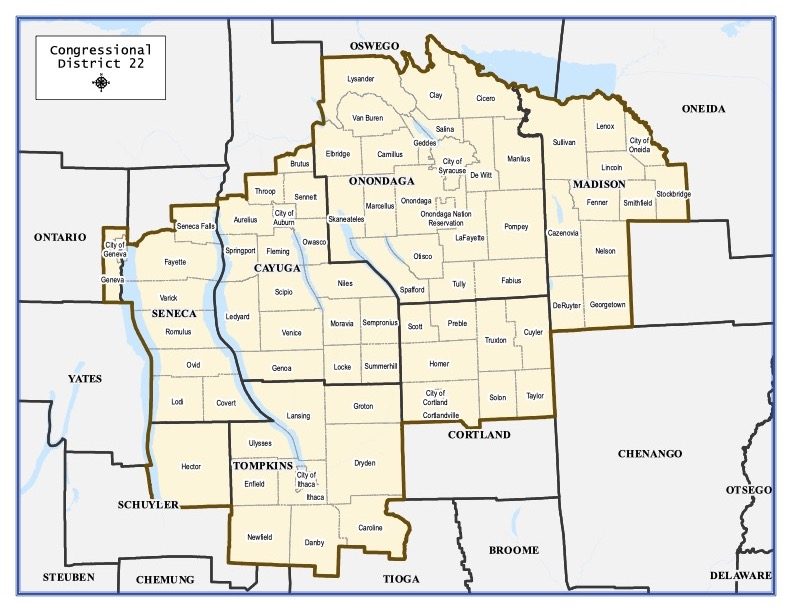Congressional District 22 introduces changes to central counties
Congressional District 22 introduces changes to central counties

New York lawmakers have approved a new congressional map that redraws county lines in central New York to form a new district.
Approved in February, the new map seeks to erase the 24th Congressional District in New York and reassemble it with other counties in the central New York area to form a new 22nd Congressional District.
Along with redrawing different counties to be closer together on the map, the new district will also bring a race for a seat in Congress following the retirement of incumbent Republican Rep. John Katko.
This new map features a number of both geographical and demographic changes.
One of the changes to the area is that the new map places Tompkins County in the solidly Democratic District 22 along with Syracuse and Cortland. Also within the map are Cayuga, Seneca and Madison counties.
Dustin Czarny, the Democratic Election Commissioner for Onondaga County, noted that the new district works to compact more central New York cities in the district compared to the old District 24.
“It’s more regularly formed, it doesn’t spread out from Syracuse to Wade, it now goes from Syracuse down to Ithaca and Tompkins,” Czarny said. “It really adds the central city components to it like Auburn.”
The new District 22 largely combines the old 22nd, held by Rep. Claudia Tenney, and the old 24th, held by Rep. John Katko, both Republicans. Katko retired last month, and Tenney announced she will instead be running for the new District 23.
Czarny said that this map reflects Central New York voting patterns more accurately than the previous district. The new map is something that Czarny states shows how the region voted for presidents and governors.
He also said that the old map had them next to northern counties like Oswego which he said are more demographically different than Onondaga. He said that the new map is creating a district based on similarities with more like-minded people within it.
A point of controversy with the new map is that some feel that it heavily reflects party gerrymandering. In this case, Mary Kuhn, a legislator for Onondaga County’s seventh district, feels that the map is drawn in such a way that it heavily favors the Democrats.
“The shift from the old 24 to the new 22 is a much more Democrat-friendly district than 24 was. The addition of Tompkins County is certainly more Democratic,” said Kuhn.
Czarny disagrees with this notion that the new district is a sign of party gerrymandering. The aspect of the new map that goes against the idea of it being gerrymandering has to do with the compactness of the district, Czarny said.
“There can be complaints about the NY maps that are long winding districts and can be seen as a gerrymander,” Czarny said. “Just because it favors a party does not mean it’s gerrymandering. A gerrymandered district would have people able to see that there are excised portions of the district.”
Something that Kuhn said she believes is that this new democratically-leaning district will have a large impact on the upcoming primary election.
Going into the primary, there are currently seven Democrats vying for the 22nd District seat in congress. It is believed by Kuhn and other politicians that the probability of a Democratic victory is high as there is currently only one Republican vying for the seat.
The seven Democrats vying for the party’s nomination are currently Francis Conole of Syracuse, Steven Holden of Camillus, and Sarah Klee Hood of DeWitt, Chol Majok from the Syracuse Common Council, Josh Riley of Ithaca, and Sam Roberts, of Syracuse.
Each of the Democratic nominations come from a variety of experiences consisting of grassroots, military and local government.
The Republicans have already selected their candidate from a three-way race, deciding upon Mike Sigler, a Tompkins County legislator of 12 years.
Czarny said that the selections of the parties does reflect a negative aspect of the new maps in regards to party favoritism.
“Here’s where I will criticize the New York process,” Czarny said. “The NY process is definitely Democratic-based bias. There were not many competitive districts that came out of the NY redistricting process.”
He said that in Democratic districts, Democrats are leaning towards primaries while Republicans are going to be facing a harder election come this fall.





